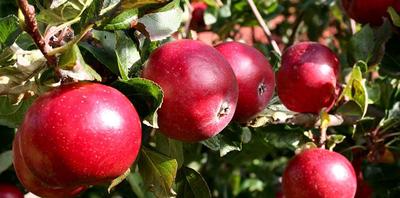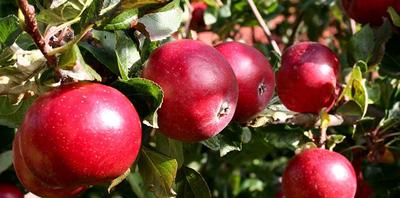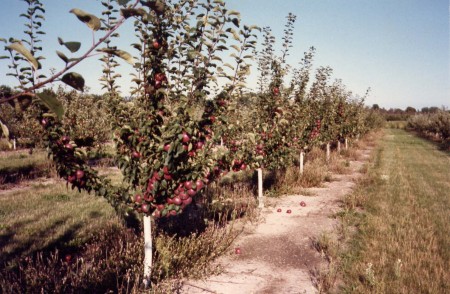The apple tree loves medium loamy, humus soil. If you have sandy soil on your property, this will require additional effort on your part to create a favorable environment for plants in your garden.
Let's start with landing. On sandy soil, you should not dig a deep hole for a seedling; fill it with fertile soil. This humus “oasis” will not last long for a growing tree. Root it by going beyond limits of the landing pit, are doomed to develop in hungry sand. It will be difficult for them to provide food to the above-ground part. Mineral fertilizers alone will not be enough for the tree.
At the place where the apple tree is planted, dig a shallow hole (10 cm) with a diameter of 40-60 cm. Fill it with humus soil so that a small mound 10 cm high is formed above the ground. Plant the tree here. Water it well, but do not feed it in the first month.
After a month, add humus to the tree trunk circle, and sprinkle a 5 cm layer of rotted sawdust or dry straw on top. Make sure that the soil under the mulch does not dry out.
Do not destroy weeds growing around the seedling, but only mow down the tops.
In autumn, in two places (opposite) along the perimeter of the crown, make holes 20 cm deep and add 1 teaspoon of urea. For a grown tree (3-5 years old), you can add 1 tbsp. spoon of urea.
Next spring, the garden can be seeded with grass that grows in your area. But mow it regularly in the summer (twice), feed it with urea (1 teaspoon per sq. m). Leave grass clippings in place. No additional fertilizer is required. In the fall, add urea to the holes - 20 g per square meter. m.
In subsequent years, apply manure to the apple trees. But don’t scatter it: on the sand it quickly washes out and burns in the hot sun. Sprinkle in piles around the perimeter of the trees. The fibrous roots of the trees approach these piles from below and receive the necessary nutrition. And the central root goes deep: in case of drought, it will provide the apple tree with moisture.
Sodding and applying organic fertilizer in heaps continually replenishes organic deficiencies in sandy soil.
Instead of regular (weed) grass, you can sow winter rye in the rows of the garden as a cover crop. In the spring (late March - early April), the plants are dug up on the bayonet of a shovel.
Not only the green mass, but also the roots of plants leave a large amount of organic matter in the soil. They improve the structure of sandy soil and increase its fertility.
Therefore, sandy (and not only sandy) soil should always be covered with plants. If in some area there is no mulch or growing plants, it means that all the organic matter there has already been consumed and is not replenished. It is impossible to create fertile soil without the participation of plants.
Apply organic material to areas where trees, shrubs and other crops will grow if you do not have the energy and time to cultivate, mulch and sod the entire garden area.
Green mulch will help you retain moisture even in sandy soil. Apply organic matter to the soil regularly in small portions, rather than adding large amounts at the beginning (or end) of the season.
Constant mulching is the best way to feed the soil with the least amount of effort and money.
Do not bury organic matter deep in the sand. At depth there is little oxygen, and the process of converting organic matter into humus takes a long time.
The use of mineral fertilizers does not increase soil fertility. They can be used to feed plants, but only in very moderate doses, so as not to disrupt the activity of soil microorganisms that create humus.




 (8 ratings, average: 4,63 out of 5)
(8 ratings, average: 4,63 out of 5) CUCUMBERS NEVER GET SICK, I'VE BEEN USING ONLY THIS FOR 40 YEARS! I SHARE A SECRET WITH YOU, CUCUMBERS ARE LIKE THE PICTURE!
CUCUMBERS NEVER GET SICK, I'VE BEEN USING ONLY THIS FOR 40 YEARS! I SHARE A SECRET WITH YOU, CUCUMBERS ARE LIKE THE PICTURE! You can dig a bucket of potatoes from each bush. Do you think these are fairy tales? Watch the video
You can dig a bucket of potatoes from each bush. Do you think these are fairy tales? Watch the video
 How our fellow gardeners work in Korea. There is a lot to learn and just fun to watch.
How our fellow gardeners work in Korea. There is a lot to learn and just fun to watch. Eye trainer. The author claims that with daily viewing, vision is restored. They don't charge money for views.
Eye trainer. The author claims that with daily viewing, vision is restored. They don't charge money for views. A 3-ingredient cake recipe in 30 minutes is better than Napoleon. Simple and very tasty.
A 3-ingredient cake recipe in 30 minutes is better than Napoleon. Simple and very tasty. Therapeutic exercises for cervical osteochondrosis. A complete set of exercises.
Therapeutic exercises for cervical osteochondrosis. A complete set of exercises. Which indoor plants match your zodiac sign?
Which indoor plants match your zodiac sign? What about them? Excursion to German dachas.
What about them? Excursion to German dachas.
Yes, of course there are a lot of nuances, I didn’t even expect that everything was so complicated, but I really want apples, and what’s a garden without apple trees! Still, I want to know when can I expect a harvest from young seedlings?
Elena, when planting annual seedlings, you eat the first apples after five years, but the apple trees reach full strength only after 8-10 years. Long, but what can you do? For dwarf apple trees, these periods are reduced to 3 and 7 years, respectively.